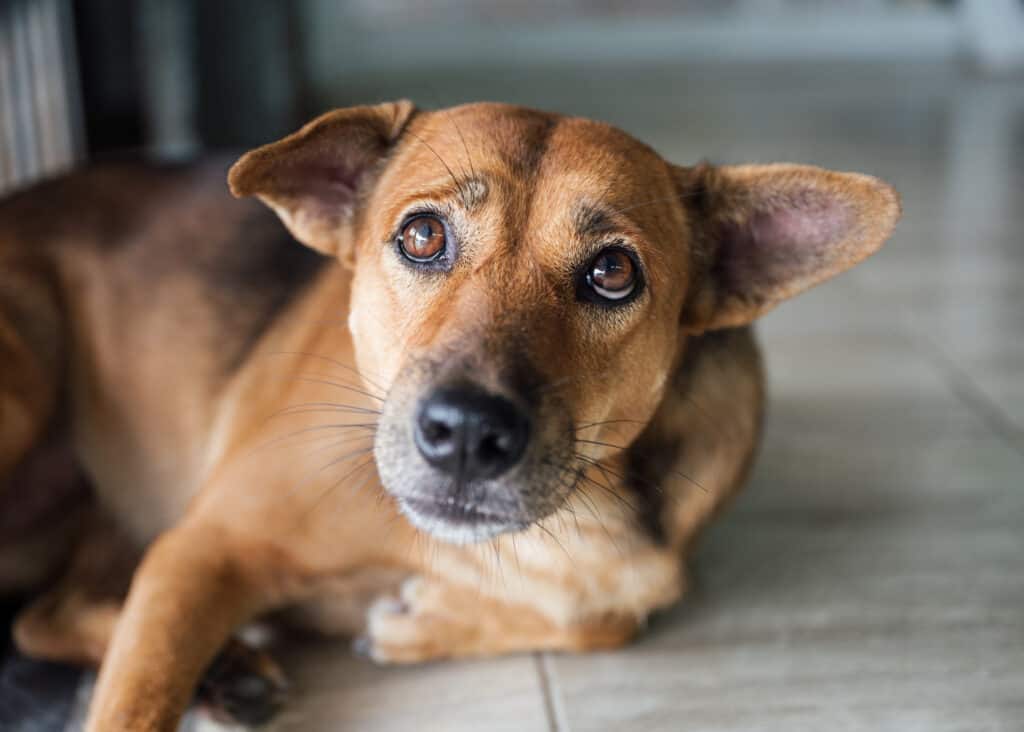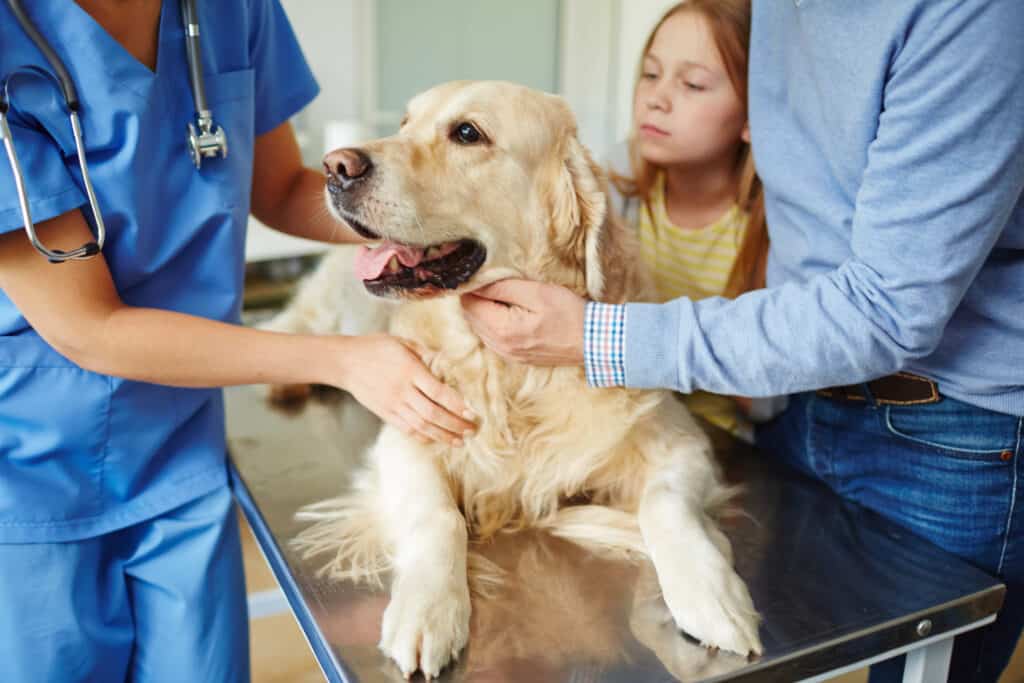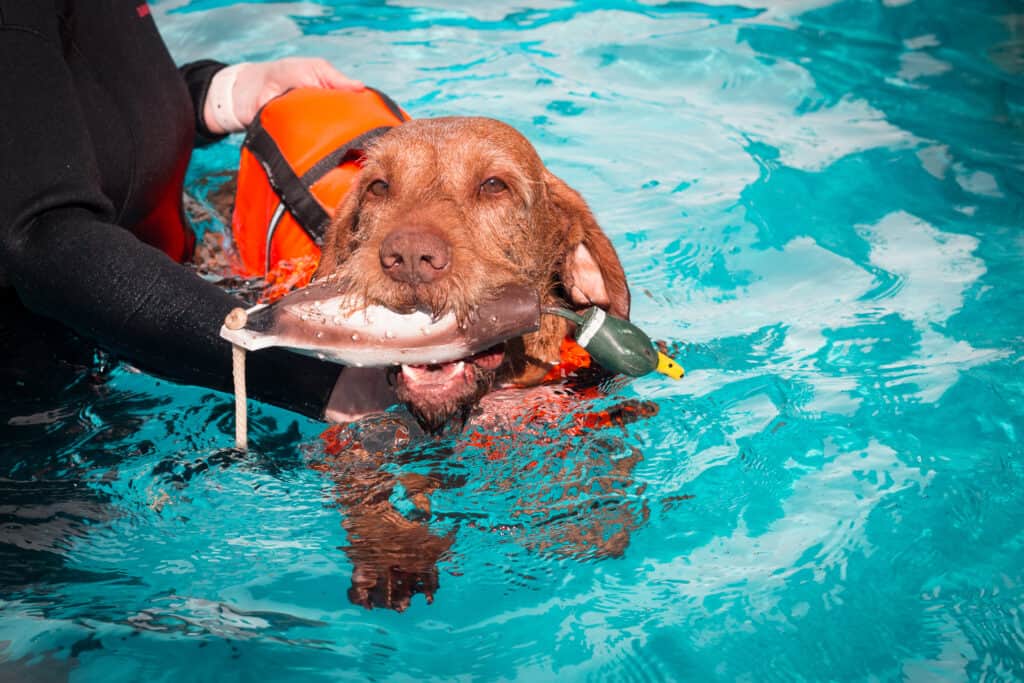If your dog has just been diagnosed with a torn ACL, you are likely searching for answers on what to do next for your little one. An ACL injury in dogs can be overwhelming for a variety of reasons, as there are many different factors to consider moving forward. Ranging from what treatment options are best to how long the standard recovery period is, most pet parents will be searching for helpful guidance throughout this journey.
Your veterinary team can help weigh through the best treatment options for your dog, but we know how important it is to have all the information in one place. We want to help you make the best decision possible for your dog with an injured or torn ACL, so let’s discuss everything you need to know about the potential treatment options for a torn ACL in dogs below!
Let’s dive in!
What is a Torn Anterior Cruciate Ligament (ACL) in Dogs?
Before we dive into our discussion on the best treatments for a torn ACL in dogs, it’s important to understand the details of this serious knee injury in our canine friends. Our dogs have a collection of muscles and ligaments that wrap around the knee and offer support to the limb, each of which provide the stabilization they require to move throughout the world. While you and I have an anterior cruciate ligament (ACL) that offers our knee its main source of support, our dogs have a cranial cruciate ligament (CCL) instead. The canine CCL plays a similar role as the human ACL within the dog’s knee, so you will often hear these terms used interchangeably when describing the life altering knee injury in dogs.
The cranial cruciate ligament in dogs is one of the main stabilizers within the canine knee, so any injury to this ligament can lead to life altering complications with movement. Not only will an injured CCL in dogs make it near impossible to move around freely, but it will be incredibly painful for the dog affected. Most dogs will be unable to put any weight on the injured leg, and the injury will only continue to worsen until some form of treatment is explored. Just like a torn ACL in humans, a torn CCL in dogs is a serious injury that requires immediate action.

Not only will an injured CCL in dogs make it near impossible to move around freely, but it will be incredibly painful for the dog affected.
©iStock.com/Mumemories
How Did My Dog Tear Their ACL? Possible Causes
If you are the parent of a dog that has just torn their ACL, you are likely wondering how this injury could have happened. While dogs can injure their cranial cruciate ligament in a variety of situations, there are a few common scenarios that typically bring dogs into an animal clinic with sudden knee injury.
Some of the most common causes of a torn CCL in dogs include:
- Dogs tripping over a hole or stepping in a hole while they are running
- Sudden twisting injuries of the knee, most often when a dog suddenly changes direction when they are running
- Jumping off a high surface and landing on the knee with intense pressure
- Deterioration of the ligament due to previous injuries to the knee region, canine obesity, a history of intense exercise, and joint disease within the knee joint
- Improper breeding or inadequate nutrition that led to impaired growth of the dog
No matter how your dog managed to tear their CCL, this injury can lead to a variety of complications for the pup affected. Dogs with a torn cranial cruciate ligament can experience limping, inability to put any weight on the limb, crying out when trying to use the limb, reluctance to exercise, difficulty sitting comfortably, swelling of the knee joint, decreased range of motion and flexibility, and even thickening of the knee joint itself. A cranial cruciate ligament injury in dogs can range from a partial strain to a complete tear, so these symptoms will often vary from dog to dog.
I Think My Dog Tore Their ACL – How Can I Help Them?
From the moment you think your dog could have torn their CCL, there are a couple steps that we recommend exploring first. No matter what the ultimate diagnosis is or how severely your dog injured their cranial cruciate ligament, the most important thing to do is to immediately restrict their exercise. There will often be a short period in which you notice the injury to the point in which your dog sees the vet, so it’s essential to prevent any progression of the injury during this time period.
Even if you are unsure of what structure within the knee that your dog injured, keeping them off the leg as much as possible is best. Strict exercise restrictions will involve only letting your outside for quick potty breaks, keeping your pup on a leash when they do go outside, keeping them cage rested when you are not there to monitor them, and making sure they have an orthopedic bed to rest on. No matter how severe your dog’s CCL injury is, strict rest will only help their situation.
The next step we suggest taking from the moment you notice a knee injury in your dog is to reach out to your vet for guidance. By explaining your dog’s symptoms and the injury that has led to their pain, your vet can determine whether or not your dog needs to come in for an assessment. If they do suggest that your dog comes in for an exam, they can perform the diagnostics needed to get to the bottom of your dog’s sudden leg pain. The sooner you reach out to your vet after your dog’s leg injury, the sooner they will be on their road to recovery!

An orthopedic dog bed can be helpful in keeping your dog rested after injury and during recovery from surgery.
©iStock.com/AngelaBuserPhoto
What is the Best Treatment for a Torn ACL In Dogs?
Once your vet diagnoses your dog with a torn ACL, it is time to explore the potential treatment options that are on the table. We understand how overwhelming this all can be, so let’s break down everything you need to know about each treatment option your vet may suggest below.
Following Strict Rest Guidelines for a Torn ACL In Dogs
No matter which treatment option your vet suggests for your dog with a torn ACL, strict rest will be a major part of their road to recovery. The cranial cruciate ligament in dogs will require exercise restriction whether it is strained or completely torn, as any aggravation to the ligament during the healing process can set the dog back drastically. This rest might be prescribed in place of surgery or after surgery, and it will come with specific instructions based on the treatment option your pup received. You can typically expect exercise restrictions to be prescribed for anywhere from 8 to 14 weeks based on the situation, so it’s best to automatically plan for this from the start.
As we mentioned above, adequate exercise restrictions are all about taking the stress off the cranial cruciate ligament and allowing the body to heal. We only want your pup to use the affected limb when they absolutely have to, which typically includes short bathroom breaks outside or during any recommended physical therapy. Some of the most effective ways to implement exercise restrictions includes keeping your dog on a leash when they go outside, keeping your dog in a crate or small space when you cannot monitor them, preventing them from jumping on or off any furniture, offering them a supportive dog bed, and encouraging rest as much as possible.
If you are struggling to keep your dog calm during their recovery period, you can always speak with your vet about any sedatives they might be able to prescribe. It can be difficult to keep your pup calm once they begin to feel better, so veterinary prescribed sedatives can be a wonderful way to limit their desire to play.
Surgery Options for a Torn ACL In Dogs
If your dog has a complete tear of their CCL, your vet will likely recommend moving forward with surgery. Surgical repair of a torn CCL in dogs is the most reliable option with the least amount of variables, and it limits the risk of complications within the knee joint over time. Dogs with a complete tear of their CCL may never regain full function of the knee if the ligament is not surgically repaired, and this will often increase their risk of further injury and pain to the area. When a dog has CCL surgery and the recommended treatment plan is followed, most dogs will have a great prognosis moving forward. No surgery success is every guaranteed, but a dog with a torn CCL has a much higher chance at regaining full use of the limb than one that does not receive surgery for their torn CCL.
If your vet does recommend CCL surgery for your dog, they will likely walk you through the treatment approach they suggest for your dog’s specific situation. There are different types of CCL surgeries in dogs based on their body size and the severity of their injury, so they will discuss the approach that is best for your canine friend. The most common CCL surgery types in dogs include a Tibial Plateau Leveling Osteotomy (TPLO), a Tibial Tuberosity Advancement (TTA), and a Lateral Suture Repair.
No matter the surgical option they choose for your pup, the standard recovery time is anywhere from 8 to 12 weeks until they begin to have full function of the leg again. This recovery period will often involve strict exercise restrictions at home and the potential for physical therapy, but your vet will make sure to offer you tailored instructions for their road to recovery.

Surgical repair of a torn CCL in dogs is the most reliable option with the least amount of variables.
©iStock.com/shironosov
ACL Knee Braces for a Torn ACL in Dogs
If your dog has a partial tear to their CCL, or surgery is not an option for any reason, then your vet may discuss the use of a dog ACL brace for treatment. Though using a brace is not as effective as surgery in regards to a torn CCL in dogs, it is a more conservative approach that can still help the dog regain function of their limb over time. Many pet parents choose to forgo CCL surgery for a variety of reasons, ranging from advanced age of the dog to financial concerns that come along with the CCL surgery cost. Using a knee brace instead of surgery might increase the risk of joint disease and bony spurs in the knee joint over time, but it is still a viable option for the canine friends that cannot have surgery.
If your vet recommends using a CCL brace for your dog, then this treatment option will rely on supporting the knee until the injured CCL can heal on its own. A knee brace for dogs will help to stabilize the knee with each step the dog takes, which allows the ligament to rest properly as scar tissue begins to form in the area. As the scar tissue forms around the injured CCL and begins to stabilize the knee joint over time, this will hopefully result in a functional limb that the dog can use comfortably once it heals. A CCL brace for dogs will also help to prevent further injury to the cranial cruciate ligament as it heals, as well as offer pain relief with each step the dog takes.
Due to the fact that a CCL brace relies on the natural healing of the body, some dogs will need to be in a knee brace for an extended period of time. Some dogs will need to wear a knee brace for anywhere from 2-6 months, but this will all rely on how severe the initial injury is. Recovery with a brace alone does not offer a concrete recovery plan, but again, it is still beneficial for dogs that cannot have surgery.
- Features a lateral aluminum splint
- Works to stabilize the knee and reduce movement
- Offers an ergonomic design
- Constructed from neoprene to help keep dogs comfortable
- Available in nine different sizes (mini to XXL) for both left and right legs
- Provides support and stability to knee joint
- Helps relieve pain
- Speeds up recovery
- Brace has 10 spring side stabilizers
- 7 sizes to choose from
- Improves stability and balance
- Offers superior comfort
- Helps to reduce pain caused by cruciate ligament injuries
- Enables faster recovery
- Available in eight different sizes ranging from XXX-small to XX-large
- Choose a right- or left-sided brace depending on which knee needs support
- Size guide to ensure a proper fit for your pup.
Physical Therapy for a Torn ACL in Dogs
Physical therapy is a treatment option that is typically explored in addition to other CCL treatment options for dogs. Whether your dog receives CCL surgery or they use a CCL brace to heal, many dogs will still need additional support to help restore full function to the injured limb. Physical therapy for a torn CCL in dogs can help to reduce inflammation in the knee as it recovers, strengthen the surrounding muscles in the leg, as well as improve the dog’s range of motion in the future. Just as you and I would likely have physical therapy if we tore our ACL, many vets will recommend this for dogs as well.
If your vet does want your dog to undergo physical therapy, this will typically begin within 1-2 weeks of their initial treatment. Different forms of physical therapy for dogs with a torn cranial cruciate ligament can include water therapy, range of motion exercises, laser therapy, and even acupuncture. Every case will vary, so we suggest speaking with your vet in detail about which therapy option is best for your pup.

Physical therapy options for dogs with a torn CCL can include hydrotherapy which helps strengthen the surrounding muscles in the leg.
©Shakarrigrafie/Shutterstock.com
Does My Dog Need Surgery for Their Torn ACL?
If your dog has just torn their CCL, you are likely wondering whether or not they will need surgery in the near future. While this is a question that only your vet can guide you properly in, we can still offer you some support with making this ultimate decision. To help you determine if surgery is the right fit, let’s list a few questions that you should begin to consider.
- Does your dog have a complete tear of their CCL? If so, surgery is the most reliable treatment option in terms of regaining full function of the limb and avoiding further complications down the line.
- Does your dog live an active lifestyle? If so, surgery is likely the most effective option, as it will offer them the most reliable limb function in the future. The more active the dog is, the more at risk they are of future CCL complications if it is not surgically repaired.
- Do you have a large breed dog? If so, surgery is typically recommended due to the increased stress that is put on the knee each day due to their body size.
- Is your dog experiencing significant pain and inability to put any weight on the limb? If so, this could mean that recovery without surgery will be much more difficult for your pup to manage.
- Do you have the budget for a CCL repair surgery in dogs? If finances are not an issue, then CCL surgery in dogs is the most effective way to heal their injury and offer them full limb function in the future. Costs will vary from dog to dog, but most pet parents can expect anywhere from $3,000-$4,000 in costs.
Once you discuss these questions in detail with your vet, you can determine the best plan of action for your dog moving forward! If you do not think surgery is the right option for your canine companion, then we suggest speaking with your vet in detail about your options. There are still ways to offer them relief with a more conservative approach, and recovery without surgery is still possible for many furry friends.
Final Thoughts
A torn ACL in dogs is an impactful injury that will require ongoing support moving forward. There are a variety of treatment plans that you will need to consider for your dog, but your veterinary team can offer you skilled guidance each step of the way. Be sure to review the details we discussed above about your dog’s CCL treatment options, and you can make the best decision for your pup!
Up Next
- Torn ACL Symptoms In Dogs: What To Look For
- Dog ACL Surgery: Price, What It Fixes, and Recovery
- Best ACL Braces For Dogs
The photo featured at the top of this post is © Andy Gin/Shutterstock.com
Ready to discover the top 10 cutest dog breeds in the entire world?
How about the fastest dogs, the largest dogs and those that are -- quite frankly -- just the kindest dogs on the planet? Each day, AZ Animals sends out lists just like this to our thousands of email subscribers. And the best part? It's FREE. Join today by entering your email below.
Sources
- American College of Veterinary Surgeons, Available here: https://www.acvs.org/small-animal/cranial-cruciate-ligament-disease
- Veterinary Orthopedic Sports Medicine Group, Available here: https://vetsportsmedicine.com/services/service-2/cranial-cruciate-ligament-ccl-injury
- VCA animal hospitals, Available here: https://vcahospitals.com/know-your-pet/cruciate-ligament-rupture-in-dogs
Thank you for reading! Have some feedback for us? Contact the AZ Animals editorial team.










